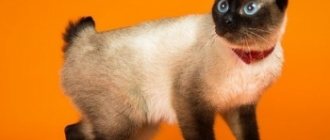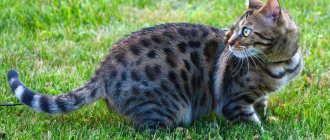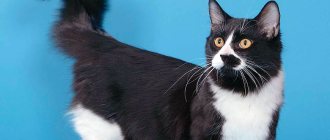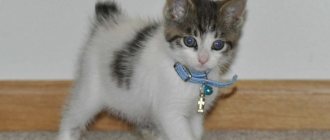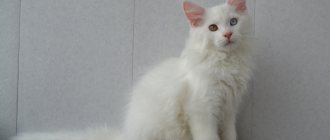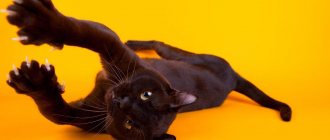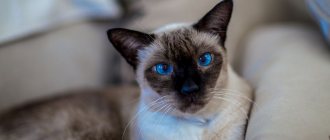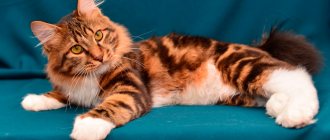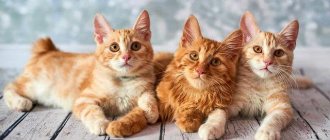The Egyptian Mau is the sacred cat of Ancient Egypt. In ancient times, they were considered divine creatures, these animals were worshiped, they were held in high esteem by the pharaohs and were even mummified with them.
According to the law, a person who pushed a cat would lose a limb. You can still see images of the Egyptian Mau in ancient pyramids; she had her own statues.
Over the centuries of the breed's existence, love for them has not faded at all; on the contrary, now it is only growing. No wonder, because this animal amazes with its grace, beautiful appearance and funny disposition.
Origin of the breed
The history of the Egyptian Mau is fascinating. The first mentions and images of temple cats date back to 4000-2000 BC. Animals were revered as embodiments of deities and were kept in comfort and honor.
According to one version, the god Ra inhabited the body of a cat. A dexterous and strong predator fought with the incarnation of the deity of chaos and darkness Apophis. The victory of the supreme spirit of the sun was marked by a new dawn every morning.
According to another version, the Mau were the personification of Bastet - the goddess of fertility, love, fun, happiness and joy. She was depicted as a woman with a cat's head.
The ancient Egyptians treated their pets and temple pets with special reverence. After the death of the body, they were embalmed and left in the resting place of the people. In the event of the death of a pet, the owners wore mourning and ritually shaved their eyebrows as a sign of great sorrow.
If someone killed a cat, they faced severe punishment and, in some cases, the death penalty.
Images of Egyptian cats with long legs, a wide chest and a thin body accompany the cultures of all human civilizations. Bronze figurines are found during the Roman Empire. Large cats are depicted on artists' paintings, jewelry, tapestries and sculptures.
The modern history of the Egyptian Mau dates back to 1952, when the Russian princess Natalya Trubetskoy acquired several kittens from the Egyptian ambassador to Italy. Subsequently, she took her favorites with her to the USA and there, thanks to selection, she achieved maximum similarity of the breed with the ancient Egyptian ancestors.
Already in 1968, the Mau became champions of America and received recognition from local felinological communities. The first nursery and community of breeders was organized. In 1977, cats of this breed received CFA certification and permission for international representation at exhibitions.
Initially, the ancestors of the Mau were domestic Egyptian cats, but over the thousand-year history of selection, the blood of Indian, European and American representatives was mixed into them.
Varieties
There are no separate subspecies in the breed, but work on restoring the breeding stock in the middle of the last century was carried out in several countries at once, which made it possible to distinguish three breed lines.
- Egyptian. Future “breeding breeders” were caught right on the streets. In fact, Egyptian yard cats were selected that fully meet the Mau standards. It was they who passed on strong indigenous health to the modern, exclusive Egyptian Mau.
- American. Those same descendants of Princess Trubetskoy’s wards, whose legacy was carefully developed by American breeders. The breed was bred on the basis of matings with obviously unrelated animals - both imported from Africa and native breeds of other continents.
- Indian. Also the result of mating of one of the Mau with native Indian cats. Later, the Indian Mau mestizos became one of the progenitor breeds of Bengal cats and the Ocicat.
At the moment, the Egyptian Mau cat breed is considered mature enough that interbreed matings are prohibited.
Breed exterior
The Egyptian Mau is distinguished from other breeds by many appearance features characteristic only of this species. Thus, the first things mentioned in the description are the long graceful body and paws, the characteristic pattern on the top of the head called a “scarab,” as well as bright “arrows” from the corners of the eyes to the ears.
Head and muzzle
The Mau has a wedge-shaped, rounded head shape with a characteristic curve between the nose and forehead. The ears are triangular in shape, wide at the base and pointed, sometimes with small tassels, at the tips.
The nose is smooth along its entire length, without widening at the bridge of the nose. The eyes are large and almond-shaped. The color of the iris is predominantly light green, less often with a yellowish tint.
Body
The Mau has an elongated, muscular body of medium length. Between the hind legs on the stomach you can find a fold of skin, which provides the cat with greater flexibility and mobility when jumping and when walking. Legs are proportional and thin. The paws are small with long sharp claws. The tail is of medium length. At the pointed tip there is a longer axial hair, visually resembling a spikelet.
Color
Egyptian Mau are short-haired cats with dense fur that lies close to the body. They have practically no down. The wool is soft and silky to the touch.
Breed standards include three main color types:
- Silver is a light gray or metallic color with contrasting dark stripes and black trim around the mouth, nose and eyes.
- Bronze - dark brown with a golden sheen, gradually moving from a dark back to a lighter belly. The stripes are dark chocolate or brown.
- Smoky – silver or gray color, without pronounced ticking. The stripes are black and very contrasting.
Signs of a pure breed are the following marks:
- Two clear lines from the eyes and cheeks to the bottom edge of the auricle.
- One or more interrupted bands on the neck, called "necklaces".
- Concentration of small stripes on the forehead and crown in the form of the letters M (above the eyes) and W (at ear level), which, and necessarily “makeup” - two lines under the eyes, running along the cheekbones.
- On the sides and back there are only contrasting intermittent spots that do not merge into stripes. Spots on the belly are required.
Selection work to improve the breed continues to this day. Breeders are trying to make the features more pronounced.
In the long term they want to achieve:
- Distinct speckles without vertical markings.
- Disappearance of triangular spots, leaving only round ones.
- Perfect contrast between the background and the design.
Character and behavior
Egyptian Mau are cats endowed with ebullient energy. They are constantly on the move, needing games and physical activity.
If you do not teach a kitten the rules of appropriate behavior, over time it will grow into a real destroyer and aggressor.
These are loyal, loving animals who treat all family members with equal attention. They get used to their owners and do not like it when strangers are present in the house.
Mau are extremely talkative. Breeders note the pleasant deep timbre of their voices. Pets are happy to “respond” to the owner’s speech and try to get their way with persistent meowing and rumbling.
Cats of this breed are not afraid of water. If you teach them to take regular baths from early childhood, they will enjoy bathing and soaking in a warm shower.
They are natural jumpers and hunters. Therefore, for the harmonious development of Mau kittens, there should be toys and scratching posts in the house. Pets will never refuse active outdoor games with their owners, but you should not try to take away prey or food from them. Cats will defend their property, sometimes with undisguised aggression.
In general, these are smart animals with a stable psyche and good-natured disposition. However, babies need caring and patient upbringing so that their natural characteristics and inclinations do not become an obstacle to living next to a person.
Health
With the help of careful selection, breeders managed to get rid of many negative features of the breed. Nowadays, individuals susceptible to feline asthma and heart failure are much less common. Congenital heart defects now also have the character of tragic accidents, rather than patterns.
Health weaknesses include a tendency to allergies to food and some genetic pathologies. In order not to encounter a serious congenital disease, you need to be careful when choosing a nursery.
Like other breeds, the Egyptian Mau has individuals that are not subject to further breeding. These include black maus. Dark color is considered a rejection. Such kittens are much cheaper.
Usually, when purchasing a kitten, its status and further participation in breeding work are determined. Kittens with severe deficiencies are sold only after a sterilization agreement has been concluded.
Health
In the 1950s, when the Egyptian Mau first arrived in the United States, interbreeding and a small gene pool gave rise to the development of some inherited diseases. Feline asthma and serious heart problems were consequences.
However, breeders have worked hard to eliminate these problems, including importing cats from India and Egypt.
My health has improved significantly, but some problems remain, for example, allergies to certain foods. In addition, some lines have not yet completely eliminated genetic diseases, so it makes sense to talk to the owner about your cat's heredity.
If you want a pet and do not plan to participate in the show, then it makes sense to buy a black cat. She also has spots, but they are quite difficult to see. Black Mau are sometimes used for breeding, but rarely and usually they are several times cheaper than regular ones, as they are considered a cull.
However, apart from the color of their coat, they are no different from the classic Mau, and fanciers say that their coat is softer and more beautiful.
Mr. Cat recommends: living with other animals
Mau cats get along differently with other pets. More often it depends on the individual character of the animal. They get along well with other cats, but it is not recommended to keep representatives of Asian breeds with them. Both are self-sufficient leaders, which means competitive behavior can develop between cats.
Mau dogs get along worse with dogs, preferring to ignore them. Jealous individuals can openly provoke dogs into aggression.
It is best to keep birds and rodents as far away from Egyptian cats as possible. The hunting instinct will not allow them to come to terms with the smells and sounds of potential prey. The presence of a mouse and a bird in the house one way or another threatens trouble. Either the cat will get there and eat it, or it will experience severe anxiety, which can turn into neurosis.
Photo review
In the photo of cats of the Egyptian Mau breed, attention is drawn to the wise look of these animals, the hidden strength of the graceful body and the discreet but unusual color.
Content
Egyptian Mau are demanding groomers. They need to be combed approximately once a week, and 2-3 times during the molting period. It is enough to bathe a cat 2-3 times a year; only specialized hypoallergenic shampoos are used for washing.
Initially, the breed does not have strong immunity. It is worth paying attention to vaccinating the kitten and trying to protect it from contact with sick animals and the street. The Mau's respiratory system is sensitive to dust, mold, and tobacco smoke. In dusty, smoky apartments, cats quickly develop asthma and heart failure due to chronic hypoxia.
Among the representatives of the breed there are many allergy sufferers. Basically we are talking about food allergies, so you will have to approach the choice of food very seriously. They can be fed both natural food and combined specialized premium food.
In this case, it is necessary to monitor the manifestations of individual reactions and, in case of intolerance, change the diet.
Cats are very active, so the food must be sufficiently high in calories and balanced in microelements, vitamins and minerals. Representatives of the breed are prone to overeating and obesity. It is better to give them food in small portions 3-4 times a day.
Cats need their own space. It would be good if it was a special house located on a hill. Mau love it when they have a view of the entire apartment and can see what other family members are doing.
The initial health of a kitten largely depends on the purity of its pedigree. Certified breeders have managed to eliminate many genetic abnormalities.
With proper care, the average life expectancy of a cat of this breed is 12-14 years.
Care
This breed loves to eat and will quickly gain weight if allowed to do so. Sensible feeding is key in keeping an Egyptian Mau, as obesity affects its health and life expectancy.
As already mentioned, they love water, so don’t be surprised if your cat plays with it instead of drinking it.
Kittens need gentle care from birth so they can become accustomed to new people, places and sounds. You can leave the TV or radio on to get them used to the noise. They don't like rough handling, so grab them with both hands, under the belly.
You need to trim your kitten's claws and brush it as early as possible so that it becomes a habit for him. Moreover, they love to be stroked, and their fur is short and does not get tangled.
Check your ears for cleanliness once a week and clean as needed. But their eyes are large, clear and do not water, at least the discharge is scanty and transparent.
Mau should be washed as needed, as their coat is clean and rarely becomes greasy. However, this is a fairly simple task, since they tolerate water well.
Choosing and purchasing a kitten
A small breed in Russia. You can buy guaranteed purebred kittens in the USA or Europe. The average price for a baby is from 2,000 to 4,000 euros. The cost is influenced by gender, age, exterior characteristics, origin and health of the parent couple and many other factors.
Some kittens from birth look fluffy with disheveled fur without a distinct pattern. This feature is considered the norm and is justified by evolutionary necessity. Ancient ancestors hid their babies in short, sparse grass, so the cubs have a texture and coat color that is as close as possible to dusty, dry land with sparse vegetation. With age, the vellus hair fades, and cats will look like small domestic leopards.
Advantages and disadvantages
The main positive features of the Egyptian Mau are considered to be activity, mobility, friendly disposition, high intelligence and touching devotion to the owner.
They get along well with children, participating in all outdoor games. These are attentive, affectionate cats, sensitive to the well-being and mood of the owner.
No wonder their ancestors were considered healers. The pet often lies down on a sore spot and warms the owner with its warmth.
Arguments against the breed include poor health, capriciousness to living conditions, and susceptibility to allergies. The breed is very rare, so the waiting list for kittens can last for years. In addition, crossbreeds with a similar color are often passed off as Mau.
Future owners should carefully consider their strength in raising a kitten and maintaining it. Babies require patience and attention to learn the rules of living with people and other animals.
Photo gallery of Egyptian Mau:
TOP nicknames
Egyptian Mau are often called by names associated with their homeland, the Nile Valley. There are often animals named after heroes of films and books, show business stars and other prominent personalities.
For example, nicknames for the Egyptian Mau “boy”:
- Osiris;
- Cairo;
- Tutankhamun;
- Chad;
- Imhotep;
- Canty;
- Dundee;
- Menes;
- Ra;
- Ramses.
Nicknames for Egyptian Mau “girls”:
- Isis;
- Jeserite;
- Nefertiti;
- Palada;
- Naomi;
- Cleopatra;
- Mandisa;
- Sahara;
- Subira;
- Sherity.
